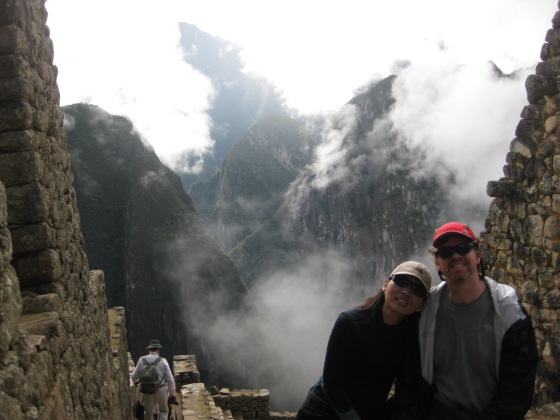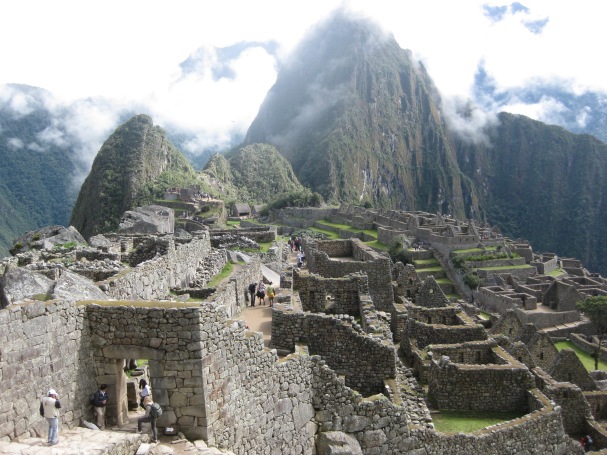Part VII…The Lost City of the Incas
*This post originally appeared on the blog in early 2018…We have re-posted for the enjoyment of all during our ‘Summer re-runs” while Brian and Sylvia are in search of new adventures.
Machu Picchu was never really lost, nor was it truly a city of the Incas. American Hiram Bingham explored and documented the ruin, at the time mostly covered by the jungle, in 1911. But locals had known of it for generations, growing corn in its lower terraces. And most archeologists believe that due its relative remoteness from the Empire and the size of its terraces, it was not truly a self-sustaining city but more likely a winter palace for the Incan royalty. Though it is located at 7700 feet, this is the lowlands by Incan standards. They would have found the climate quite balmy.

Whatever the truth, the image of the “Lost City of the Incas” continues to captivate millions around the world. And whatever else is true, you won’t find anyplace else on Earth quite like this.
Our trip would begin in the hotel lobby in the pre-dawn…together with our guide, Willie, and our newfound friend Marco, we marched out into the darkness. The narrow streets of Aguas Calientes quickly gave way to a wide path beside the raging Urubamba river which followed the original route of the Incan road. We could see almost nothing. Somewhere overhead loomed the ruin, but we couldn’t see that either. Even our headlamps hardly sufficed to penetrate the jungle gloom.
Finally we arrived at a vast gate/bus station/football field where scored of buses sat idling and dispensing fumes, and at least two hundred people were standing in line already, waiting for the gates to open. Waiting to be the first (or among the first) to reach the ruin that day. Most of these were the ubiquitous twenty-something European student hikers that can be found everywhere in Peru. All of us in line were there to attempt the ancient stone staircase that ascends to reach the famed Lost City…Machu Picchu.
At about 6 am the gate opened and the hikers began to pour through, a racing throng of young people with headlamps, going like a passenger train into the darkness. At the time I did not understand what all the hurry was about; Machu Picchu is almost always shrouded by fog in the early morning. Getting there first admittedly allows on to beat the throngs but still, there would be little to see. So what’s the hurry? What I learned later is that most of these kids were almost certainly going to attempt either the peak of Huayna Picchu or the even higher peak of Machu Picchu proper; both have excellent views back down at the monument (Sylvia’s brother in law Max and his family hiked Huayna Picchu in 2017.) But at the time, it just seemed to be a whole lot of pointless rushing about.
As I learned both then and since, there’s no prize to be won trying to keep up with these young and often very well acclimatized trekkers. After attempting for a few fruitless minutes to keep pace with the flood, we simply stepped off the path and allowed it to pass. And in a few minutes the long procession of headlamps came to an end. Leaving us nearly alone, on the ancient staircase in the fog bound jungle, in almost complete darkness and silence.

I have read many trip reports since of this climb, apparently written by people who have not done it or weren’t in shape when they did it, all insisting that the walk is a waste of time and the money spent on the bus is much better invested. I can tell you straight up it’s a crock…there is no magic to the bus. The magic is on the trail. The experience of climbing that ancient staircase in the misty dawn, surrounded by the eerie jungle, and having it most of the way by ourselves, was one of the most unforgettable experiences of my life.
True, the stairs are steep, and the step-ups are high, and the unacclimatized will suffer in the humid air. But that is the price of adventure, which earns you rewards a bus simply cannot bring. Like the sight of huge blue hummingbirds rising silently before us in the mist, or the tall figures of the weirdly shaped surrounding peaks appearing slowly from the clouds, glimpsed as they were through the jungle vines…had we been locked inside the crowded buses with the suitcase tourists, we would have missed it all. Do yourself a favor…if you come this far, don’t be cargo. Walk, if you can!
Finally we reached the top of the great stairs and arrived at the gate of the monument, already well on its way to being mobbed. This is a singularly popular place; hundreds, most of them off the buses, jammed the gates. The Peruvian doctor, whose daughter had been experiencing some athsma symptoms, had taken the bus up and met us near the gate. (There’s no shame in riding when you are prevented from walking by circumstances beyond your control, by the way.)
Willie the guide presented us our tickets and in we went to the Lost City of the Incas. Our first look at it was not impressive…some fog bound stone terraces, and a couple of tame llamas munching sedately on the grass. No views to be had, which is the norm most mornings. Willie began his tour, happily informing us that the weather was expected to be excellent in a few hours, with the clouds soon burning off. But until the view opened up we explored the monument.




After Willie completed his tour, we were free to roam about as we pleased. Some of the most memorable moments were from this part of the day, as we wondered about watching the clouds break up and reveal the valley. While the tourists mobbed the more popular areas nearer the gate, all looking for that million-dollar view for the selfie, we stayed low in what had probably once been the servant’s quarters. We had these remarkable structures all to ourselves. I wandered from to room, gallery to gallery, up and down stairs, marveling at the works of the Inca…masters of stone.



Later of course we did go up higher to get that obligatory million-dollar view. Here’s some pictures of us, some posed with Marco, and some with the doctor and his daughter. A Japanese tourist helpfully took the one of all of us together.
The valley had mostly emerged from the clouds by now, allowing us stunning views out into the upper reaches of the Amazon basin…looking at that formidable place gave me a chill. The Amazon is one of the places on Earth I would most fear going alone.
The monument was now entirely clear for picture taking but…for some reason I just couldn’t get the right light. There was always a shadow or some stiff in a Hawaiin shirt standing in the way or something…the perfect shot eluded me.


Then, almost as we were about to leave, I was walking down a staircase and…the clouds parted and the sun shone forth and green vistas appeared before us. Suddenly, there it was. The million-dollar view. This picture, the last I took of the day, is also in my opinion the best one.

Full disclosure here…we did in fact take the bus back down to Aguas Calientes. There was no magic in going back down the stairs in the heat of day with our already ruined knees smarting. We felt we had earned the right to coast.

Postscript to the tour…after coming back down, exhausted (it was barely 1 pm) we returned to the hotel lobby, had some water and went to sit by the windows, where I spotted several members of our original group finally making their way into town, having come the entire way by foot. At a certain point I fell asleep. When I awoke, I felt dizzy and ill. And before hours had passed, I was sick as a dog, and would be sick for days hence. Finally, whatever Sylvia had caught managed to catch up to me.

But it didn’t much matter. We had come to walk to Machu Picchu…and (barring a brief car/train ride) we had done this. This was by far the most enjoyable experience of my life. I have since returned to Peru and have had other, and in some cases even greater adventures. We will return again. I would recommend to anyone who can do so to take one of the many walking routes to Machu Picchu and get out and experience the wonders of the Andes for yourself. Perhaps, you too will walk to Machu Picchu by the Salkantay Trek.

Next: Is this hike for you?